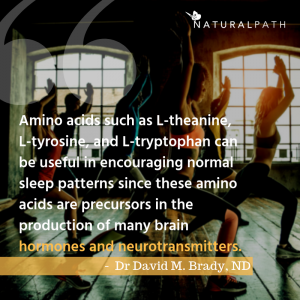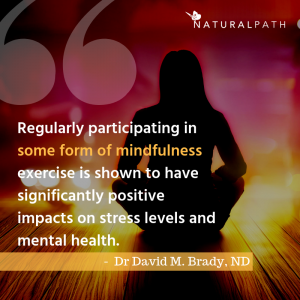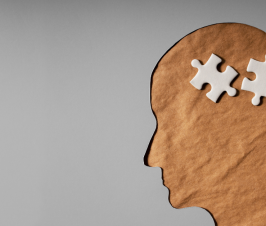David M. Brady, ND, DC, CCN, DACBN, IFMCP, FACN
Busy schedules, demanding occupations, managing children and family life, financial burdens, heavy school loads, planning for a large event such as new move or job, and the never-ending pinging of electronic devices and communications invade our everyday life. The average day in our lives feels more like a roller-coaster than a steady train and leaves us dropping into bed exhausted and spent, only to have to rise a few hours later and begin the race again. Collectively, the pressures of everyday life create a phenomena known as stress.
Everyday life creates every day stress
There is little question about the increasing levels of stress we experience as the expectations for normal life grow, but there is less certainty about its impact on our health. However, stress is increasingly becoming a root problem in most health conditions, and is an especially significant element in global pain and fatigue conditions such as fibromyalgia. Even Merriam Webster acknowledges the association between stress and disease, defining stress as “a physical, chemical, or emotional factor that causes bodily or mental tension and may be a factor in disease causation.” Physical and occupational stressors are commonly encountered throughout life. Emotional stress is more complex and often stems from weightier matters such as relationship difficulties, abuse, death, fear and anxiety. While everyone experiences temporary physical stressors throughout their life, emotional stressors can linger and lead to damaging feelings of despair and hopelessness. Both forms of stress can have a significant impact on physical and mental health, reducing the body’s resiliency and arresting the healing process. The health effects of chronic stress have been the subject of many studies in recent years, owing to the fact that it has been linked to increased risks of cardiovascular disease and upper respiratory diseases, psychiatric conditions such as depression and anxiety disorders, widespread inflammation, and autoimmune conditions. In the fight for optimal health, a commitment to daily stress reduction is no longer a recommendation, but a requirement.
 Although stress reduction is mandatory for good health, the method is highly personalized, based on numerous individual traits. Each person’s stress response is dependent on genetic vulnerability, coping mechanisms, personality, and the presence of social and familial support. All forms of stress place excess pressure and demands on the body, prompting various biological systems to respond. Individuals with a high level of resiliency and a strong support system are often able to cope with and manage greater levels of stress, compared to those whose constitution is weak and who lack the support of others.
Although stress reduction is mandatory for good health, the method is highly personalized, based on numerous individual traits. Each person’s stress response is dependent on genetic vulnerability, coping mechanisms, personality, and the presence of social and familial support. All forms of stress place excess pressure and demands on the body, prompting various biological systems to respond. Individuals with a high level of resiliency and a strong support system are often able to cope with and manage greater levels of stress, compared to those whose constitution is weak and who lack the support of others.
Chronic stress triggers the production of cortisol and catecholamines
Chronic stress triggers the production of cortisol and catecholamines such as dopamine and norepinephrine – hormones which activate the “fight and fight” response. As these hormones surge through the body, they suppress the immune system and the healing mechanisms, by blocking the production of various immune cells. Additionally, muscle wasting and nutrient deficiencies often emerge as stress persists because the body redirects vital nutrients such as sugars and proteins to support the high energy demands of the stress response, making them unavailable for maintaining good health. When experiencing high levels of stress, the body’s requirements for healthy nutrients is much greater. Stress hormones also disturb normal sleep patterns and cognitive function as they interact with and alter brain neurotransmitters. Memory, learning, and moods are frequently disturbed and conditions such as anxiety and depression often follow chronic stress. Temporary stress is unlikely to create long-term health effects; however, chronic stress easily disrupts several biological systems including the immune, digestive, cardiovascular and neurological system, illustrating why it has become a root element in various chronic health conditions, and especially in global pain and fatigue disorders such as fibromyalgia.
 Stress-Reducing Activities
Stress-Reducing Activities
Occasional stress is, quite simply, a part of human life but more often than not, the load of stress being carried is far greater than that which is considered healthy and normal. Instead, excessive stress is a characteristic of everyday life and threatens general health. Therefore, incorporating basic stress-reducing activities into a daily routine can be helpful in balancing the stress response and increasing resiliency, which will protect health and well-being.
One of the most basic behaviors that can help in reducing stress and improve health is to evaluate whether you are over-committed. Life is full of opportunities, but the human body is limited in its capacity. Therefore, learning to focus on a few important commitments, while simultaneously forgoing less important opportunities will help prevent stress associated with over-commitment. As the familiar phrase – “jack of all trades master of none” – alludes to, establishing boundaries and fully committing to a few select obligations often produces a deeper sense of satisfaction and accomplishment as time is given to do these few things well.
Regularly participating in some form of mindfulness exercise is shown to have significantly positive impacts on stress levels and mental health. Meditation, prayer and guided imagery are all excellent tools for focusing the mind. Meditation strengthens pathways in the brain that build greater awareness of the moment and ability to remain single-focused. Chronic stress often exerts itself as “mind-racing” and hypervigilance. Regular meditation and mindfulness activities can help bring thoughts into focus, improve attention, facilitate problem-solving, reduce all biological markers of stress, and improve cardiovascular health. Likewise, prayer is a form of religious meditation that confers all the same benefits as other forms of meditation. Throughout history, it has been noted that religious practices such as prayer are significantly beneficial for reducing anxiety, improving mood and mental outlook, pain tolerance, and general health. Guided imagery is another powerful relaxation tool that encourages optimism and positive thoughts. It has also been proven to improve sleep, pain, anxiety and depression. Publications on the practice and benefits of mindfulness have grown tenfold in the past decade, giving evidence to the interest, demand, and validity of mental stress reduction for health and longevity.
Tight, spasmodic muscles are often the physical response to chronic stress, provoking pain, fatigue, and weakness. Engaging in light physical activity through stretching, yoga, walks through nature, and enjoyable activities is useful for encouraging relaxation, loosening tight muscles, improving blood flow, and decreasing pain. Light physical activity coupled with a mind-focusing activity creates a perfect marriage for stress-reduction by targeting both physical and mental stress. Deep diaphragmatic breathing is another important adjunct to both mental and physical activities intended to reduce stress. Magnesium is a mineral that helps relax tight muscles. Soaking in a warm bath with Epsom salts is the most effective way to obtain magnesium since this mineral absorbs through the skin more easily than it is absorbed in the digestive tract.
External stimuli that affects the basic senses also helps to regulate the body’s response to stress. Using music and soft lighting to create a calming environment is a simple way to sustain a state of relaxation. Like guided imagery, music therapy promotes positive emotions while reducing anxiety and stress. Classical music, particularly, has been shown to positively stimulate the parasympathetic nervous system to slow the heart rate and relax muscles. Colored light has the ability to affect brain hormones such as serotonin and melatonin, both of which are important for establishing a healthy wake/sleep cycle and contribute to positive moods. Chromotherapy is a form of therapy that uses specific colors to foster positive, balanced moods. Most individuals can affirm the positive effects of warm sunlight versus the cold, fearful feelings provoked by dark, shadowy colors. Aromatherapy – which utilizes the therapeutic aroma of selected essential oils – is yet another way to generate a calming environment and reduce stress.
Stress-Reducing Botanicals/Nutrients
The endocrine system, which regulates many of our body’s hormones, is a first responder to chronic stress. This system is responsible for producing many of the hormones involved in the stress response such as cortisol (adrenaline). After employing routine methods of stress-management, secondary support can be found in various botanicals which can strengthen the biological systems involved in the stress response. Panax ginseng, Eleutherococcus senticosus, and Rhodiola rosea,are among the best known species of plants in a class of botanicals known as adaptogens. These botanicals support the adrenal glands (key organs of the endocrine system) and balance the production of stress hormones, thereby improving the body’s resiliency to stress and helping to recover. However, some of these classic adaptogens can be somewhat stimulating to the system and can make worsen issues such as anxiety and hypervigilance. However, other botanicals such as Withania somnifera(Ashwagandha) are calming and preferred. Still other botanicals such as valerian, chamomile, lemon balm, Bacopa, passionflower, and hops can help reduce anxiety, promote relaxation, and improve sleep by supporting neurotransmitters in the brain.
When chronic stress disrupts sleep, natural brain hormones such as melatonin and 5-HTP are temporarily helpful. Sleep is directly linked to pain perception and when both sleep and pain are problems, recovery from stress is nearly impossible. Similarly, amino acids such as L-theanine, L-tyrosine, and L-tryptophan can be useful in encouraging normal sleep patterns since these amino acids are precursors in the production of many brain hormones and neurotransmitters. As with botanicals, some amino acids including L-tyrosine and L-tryptophan can have opposing actions and actually provide an unwanted stimulatory effect. Therefore, they should be used under the guidance of a healthcare professional skilled in the nuances of managing the stress response with nutritional and botanical agents.
Stress is a significant roadblock to healing and as conditions such as fibromyalgia, chronic fatigue syndrome, and irritable bowel syndrome continue to surge, it is imperative to manage chronic stress. Research is continually showing stress to be a foremost concern in many health conditions and a root cause of poor health and healing. Stress-reduction often clears the muddy waters of poor health and allows for a better representation of any genuine health concerns, making it an essential lifestyle modification.
In the new book by Dr. David Brady called The Fibro Fix he provides detailed instructions on the use of daily stress reduction techniques and practices, movement/mobility exercises, and the use of nutritional and botanical/herbal therapies for stress reduction.
Dr. Brady’s new book, The Fibro Fix, will give you a wealth of information on how to negotiate your way toward getting the proper diagnosis and the proper treatment for your symptoms of widespread pain and fatigue. The book can be ordered on Amazon, Barnes & Noble, Books-A-Million and other fine book vendors, or at FibroFix.com. Also, learn more about The Fibro Fix Summitwhere Dr. Brady interviews 30+ experts on FM at FibroFixSummit.com. Also, please visit Dr. Brady’s main website at DrDavidBrady.com and follow him on Facebook at DrDavidBrady.
References:
Schneiderman, N., Ironson, G., & Siegel, S. D. (2005). STRESS AND HEALTH: Psychological, Behavioral, and Biological Determinants. Annual Review of Clinical Psychology, 1, 607–628. http://doi.org/10.1146/annurev.clinpsy.1.102803.144141
Salleh, M. R. (2008). Life Event, Stress and Illness. The Malaysian Journal of Medical Sciences : MJMS, 15(4), 9–18.
Wimmer, L., Bellingrath, S., & von Stockhausen, L. (2016). Cognitive Effects of Mindfulness Training: Results of a Pilot Study Based on a Theory Driven Approach. Frontiers in Psychology, 7, 1037. http://doi.org/10.3389/fpsyg.2016.01037
Andrade, C., & Radhakrishnan, R. (2009). Prayer and healing: A medical and scientific perspective on randomized controlled trials. Indian Journal of Psychiatry, 51(4), 247–253. http://doi.org/10.4103/0019-5545.58288
Chen, S.-F., Wang, H.-H., Yang, H.-Y., & Chung, U.-L. (2015). Effect of Relaxation With Guided Imagery on The Physical and Psychological Symptoms of Breast Cancer Patients Undergoing Chemotherapy. Iranian Red Crescent Medical Journal, 17(11), e31277. http://doi.org/10.5812/ircmj.31277
Lee, K.S., Jeong, H.C., Yim, J.E., & Jeon, M.Y. (2016). Effects of Music Therapy on the Cardiovascular and Autonomic Nervous System in Stress-Induced University Students: A Randomized Controlled Trial. Journal of Alternative and Complementary Medicine, 22(1), 59-65. doi: 10.1089/acm.2015.0079.
Radeljak, S., Zarković-Palijan, T., Kovacević, D., & Kovac, M. (2008). Chromotherapy in the regulation of neurohormonal balance in human brain–complementary application in modern psychiatric treatment. Collegium Antropologicum, 32, Suppl 2, 185-8.
Head, K.A., & Kelly, G.S. (2009). Nutrients and botanicals for treatment of stress: adrenal fatigue, neurotransmitter imbalance, anxiety, and restless sleep. Alternative Medicine Review, 14(2), 114-40.
American Mindfulness Research Association. (2019). Mindfulness journal publications by year, 1980-2018. Retrieved from https://goamra.org/resources
 David M. Brady, ND, DC, CCN, DACBN, IFMCP, FACN, has 28 years of experience as an integrative practitioner and over 24 years in health sciences academia. He is a licensed naturopathic medical physician in Connecticut and Vermont, is board certified in functional medicine and clinical nutrition, a fellow of the American College of Nutrition, and completed his initial clinical training as a doctor of chiropractic. Dr. Brady has been the chief medical officer of Designs for Health, Inc. and also currently serves as the chief medical officer for Diagnostic Solutions Labs. He is the long-time director of the Human Nutrition Institute, and associate professor of clinical sciences at the University of Bridgeport in Connecticut. He has appeared on the plenary speaking panel of some of the largest and most prestigious conferences in the field including; IFM, ACAM, A4M, ACN, IHS, AANP, AIHM and many more. He is in clinical practice at Whole Body Medicine in Fairfield, CT, specializing in functional, nutritional and metabolic medicine.
David M. Brady, ND, DC, CCN, DACBN, IFMCP, FACN, has 28 years of experience as an integrative practitioner and over 24 years in health sciences academia. He is a licensed naturopathic medical physician in Connecticut and Vermont, is board certified in functional medicine and clinical nutrition, a fellow of the American College of Nutrition, and completed his initial clinical training as a doctor of chiropractic. Dr. Brady has been the chief medical officer of Designs for Health, Inc. and also currently serves as the chief medical officer for Diagnostic Solutions Labs. He is the long-time director of the Human Nutrition Institute, and associate professor of clinical sciences at the University of Bridgeport in Connecticut. He has appeared on the plenary speaking panel of some of the largest and most prestigious conferences in the field including; IFM, ACAM, A4M, ACN, IHS, AANP, AIHM and many more. He is in clinical practice at Whole Body Medicine in Fairfield, CT, specializing in functional, nutritional and metabolic medicine.

















